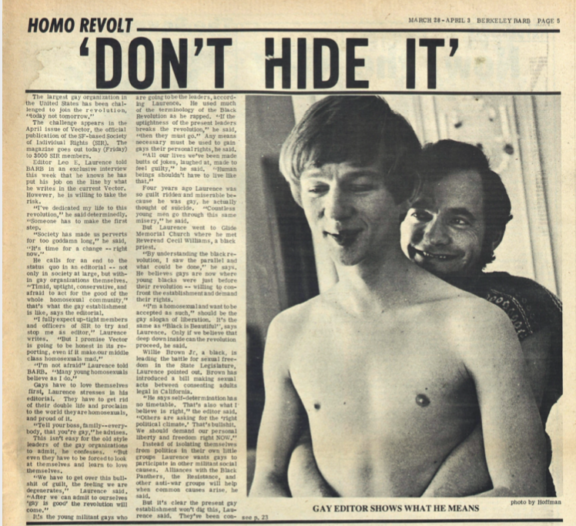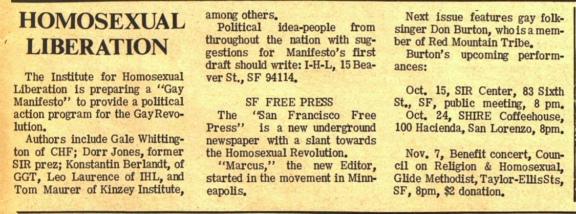The Committee for Homosexual Freedom was created in April 1969, out of a desire to form a new radical gay coaltion. Leo Laurence, one of the founding members, had previously worked as an editor for Vector, a gay publication from The Society for Individual Rights (SIR). Laurence rejected SIR’s single-issue mindset in an article titled “Homo Revolt ‘Don’t Hide It’” in the Berkeley Barb. He called for a radical alliance between the gay movement and Black Panther Party in Oakland, the anti-war movement, and women’s rights.
It’s the young militant gays who are going to be the leaders, according Laurence. He used much of the terminology of the Black Revolution as he rapped. “If the uptightness of the present leaders breaks the revolution,” he said, “then they must go.” Any means necessary must be used to gain gays their personal rights, he said. (1)
The group’s first major focus was on protesting businesses that practiced discriminatory hiring and firing practices, allowed police raids, and promoted anti-gay rhetoric. In April, 1969, the group protested The San Francisco Steamship Lines Company for firing Gale Whittington, Leo Laurence’s boyfriend, for being a homosexual.
The Committee for Homosexual Freedom’s organizational structure was decentralized and member-run. In order to vote, members had to do five hours of participation in its events, including “jail time and streets [protests]” Additionally, the leadership structure they did have was fluid, as leaders were elected every three weeks, designed to offer leadership opportunity to all members
“CHF with at least 60 voting members is the largest of several new-trend homosexual organizations in the Bay Area, others being Gay Liberation, to explore cultural and life styles with special attention to communications media; Institute of Homosexual Liberation, for political activities; Gay. Community. which is starting a scientific and literary journal, Gay Liberation Front, the Berkeley equivalent of CHF and of Gay Liberation, the San Francisco Free Press, a gay underground newspaper giving special attention and support to women’s liberation, and Gay Liberation Theatre, perhaps the most militant and active group, which has created and performed gay guerrilla theatre and gay comedy before audiences totaling thousands.” (2)
After the Stonewall riots on June 28, 1969, and the subsequent formation of first Gay Liberation Front in New York, GLF groups around the country were created. As the Committee for Homosexual Freedom was already organized, the group voted to change their name to the Gay Liberation Front in August of that year. By October, they were involved with the Purple Hand Protests on October 31, 1969 at the offices of The San Francisco Examiner. They were also involved with organizing for legal aid for the individuals arrested during those protests.
Alongside the Commitee for Homosexual Freedom, Leo Laurence and Gale Whittington formed the Institute for Homosexual Liberation, a group aimed at creating a network of gay liberation organizations across the country, and aligning itself with other revolutionary groups. In October 1969, the group set out to write a “Gay Manifesto,” a document that would outline the goals of the Gay Liberation movement.


